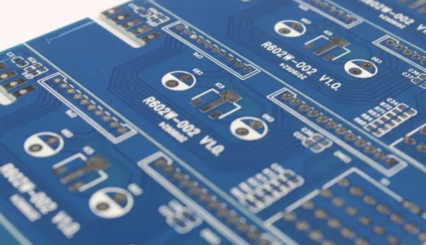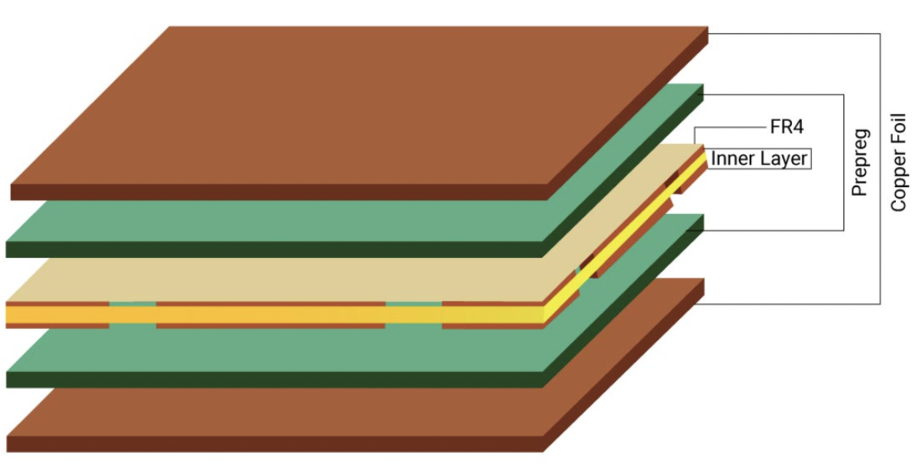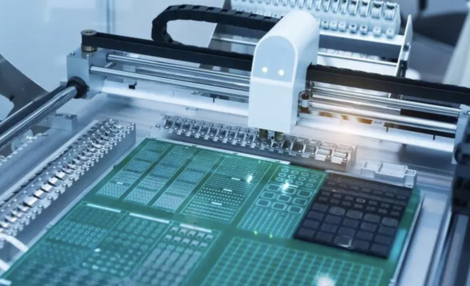Laminates are an essential material. Manufacturers use them to develop and fabricate PCBs. Thus, it’s necessary to understand the various laminates available to you. In this article, we'll learn what pcb laminate is, why it's crucial for making electronics, and how it helps signals move around. We'll also discover the different types of laminate and how to choose the right one.

PCB laminates are foundational materials used in the construction of printed circuit boards. They play a crucial role in shaping the performance, reliability, and functionality of electronic devices by providing the structural base and electrical insulation necessary for the PCB's operation.
In essence, PCB laminates are composite materials composed of layers with specific properties. These layers are bonded together through heat and pressure to create a solid, layered structure. The two primary components of a PCB laminate are the core and prepreg layers.
Core Layer: The core layer forms the central foundation of the PCB laminate. It is typically made from materials like fiberglass-reinforced epoxy resin, commonly known as FR-4. This layer provides mechanical strength, rigidity, and thickness to the PCB.
Prepreg Layer: The prepreg layer is positioned on both sides of the core layer. It consists of fiberglass cloth that has been impregnated with uncured epoxy resin. During PCB manufacturing, the prepreg layers are heated and compressed, causing the epoxy resin to cure and create a strong bond with the core layer.

There are different types of laminate materials commonly used in PCB manufacturing. Each type of laminate has its own strengths and weaknesses, making them suitable for specific applications.
| Laminate Type | Composition | Key Characteristics | Typical Applications |
|---|---|---|---|
| FR-4 Laminate | Fiberglass cloth impregnated with epoxy resin | Good electrical insulation, mechanical strength, cost-effective | Consumer electronics, industrial equipment |
| Rogers Laminate | Ceramic-filled PTFE substrate | High-frequency performance, low dielectric loss, stable electrical properties | RF/microwave applications, base stations, radar systems |
| Isola Laminate | Epoxy, polyimide, PTFE-based materials | High-speed signal integrity, thermal reliability, controlled impedance | High-speed digital circuits, RF/microwave systems |
| Metal-Core PCB Laminate | Metal core (aluminum or copper) | Enhanced thermal conductivity, effective heat dissipation | LED lighting, power electronics, automotive systems |
| Polyimide Laminate | Flexible polyimide film coated with copper | High-temperature resistance, flexibility, excellent electrical insulation | Aerospace, military devices, flexible circuits |
| Ceramic Laminate | Ceramic-filled materials | High thermal conductivity, low dielectric loss, stability at elevated temperatures | High-power, high-frequency applications |
| Flex and Rigid-Flex Laminate | Flexible and rigid layers | Design versatility, space savings, flexibility | Wearable devices, medical implants, aerospace |
| Halogen-Free Laminate | Environmentally friendly materials | Similar properties to conventional laminates, compliance with eco-friendly standards | General electronics, compliance with regulations |
| Environmental-Friendly Laminate | Sustainable materials | Reduced environmental impact, recycled or biodegradable components | Environmentally conscious initiatives |
FR-4 is the most widely used and cost-effective PCB laminate material. It is composed of woven fiberglass cloth impregnated with epoxy resin, providing good electrical insulation and mechanical stability.
High-Tg (glass transition temperature) laminates are designed to withstand higher operating temperatures compared to standard FR-4. They offer improved thermal stability, making them suitable for applications with elevated temperature requirements.
Rogers laminates are known for their excellent high-frequency performance, low dielectric loss, and stable electrical properties. They are commonly used in RF and microwave applications, such as cellular base stations, satellite communication, and radar systems.
Isola is another brand that offers laminates for various applications. Their laminates are engineered for specific performance characteristics, such as high-speed digital, high-frequency RF, and thermal management.
Polyimide laminates, known for their high-temperature resistance and flexibility, are used in applications that require extreme temperature tolerance and flexibility. They are highly fitting for PCB designs requiring multiple layers. Furthermore, manufacturers use this material for flexible PCB manufacturing.
Ceramic laminates are ideal for high-power and high-frequency applications. They offer excellent thermal conductivity, low dielectric loss, and stability at high temperatures.
Halogen-free laminates are environmentally friendly options that eliminate the use of halogenated flame retardants. They are used to comply with regulations and industry standards that restrict the use of certain hazardous substances.
Isola offers a variety of laminate materials with specific performance characteristics, including epoxy, polyimide, and PTFE-based options. Isola laminates are engineered to provide high-speed signal integrity, thermal reliability, and controlled impedance.
Let's delve into these important properties—dielectric constant, thermal conductivity, glass transition temperature, and coefficient of thermal expansion—and explore how they impact the overall performance of a printed circuit board.
The dielectric constant, also known as relative permittivity, measures the ability of a material to store electrical energy in an electric field. Essentially, it can range between 3.5 and 5.5 ϵr. It affects the propagation speed of electrical signals through the PCB. Higher dielectric constants lead to slower signal speeds, causing signal delays and potential distortion. Low dielectric constants are desirable for high-speed applications to minimize signal skew and maintain signal integrity.
Thermal conductivity is the property that determines a material's ability to conduct heat. PCBs with components that generate heat require efficient heat dissipation to prevent overheating. Materials with higher thermal conductivity help spread and dissipate heat, reducing the risk of thermal stress, component failure, and signal degradation. Metal-core laminates with high thermal conductivity are preferred for power electronics and high-power applications.
The glass transition temperature is the temperature at which an amorphous material transitions from a rigid, glassy state to a more flexible, rubbery state. Laminates lose their structural integrity when they reach a certain temperature range. Thus, we use the glass transition temperature to help identify when the laminate softens and hardens.
The coefficient of thermal expansion measures how a material's dimensions change with temperature variations. PCBs experience temperature fluctuations during operation and assembly. Mismatched CTE between different materials in the PCB can lead to mechanical stress, delamination, and solder joint failures, especially in multilayer boards. Balancing CTE is essential to maintain structural integrity and prevent reliability issues.
Selecting the appropriate laminate material for a PCB involves considering various factors to ensure optimal performance, reliability, and cost-effectiveness. Here are guidelines for choosing the right laminate material based on different considerations:
Guidelines: For good signal integrity, choose a laminate with a low dielectric constant (Dk) and low dielectric loss (Df). These properties minimize signal attenuation and distortion.
Materials: Look for laminates designed for high-speed applications, such as Isola's high-speed materials or specialized RF laminates.
Example: Rogers laminates with low Dk and Df are commonly used to maintain signal integrity in high-frequency circuits.
Guidelines: High-frequency applications demand laminates with stable electrical properties across a wide frequency range. Low loss tangent is critical to prevent signal loss.
Materials: Choose laminates specifically engineered for high-frequency applications, such as Rogers' high-frequency laminates.
Example: Rogers 4000 series laminates offer excellent high-frequency performance with low loss.
Guidelines: Optimal thermal management requires laminates with high thermal conductivity to efficiently dissipate heat. Consider the operating temperature range and thermal resistance.
Materials: Metal-core laminates or laminates designed for high thermal conductivity applications are suitable for effective heat dissipation.
Example: Metal-core laminates are commonly used in applications where thermal management is critical, such as LED lighting.
Guidelines: Balancing performance and cost is essential. Choose a laminate that meets the required specifications while fitting within the project budget.
Materials: Standard FR-4 laminates are often cost-effective choices for general-purpose applications.
Example: FR-4 laminates are commonly used in a wide range of applications due to their cost-effectiveness.
Guidelines: When environmental impact is a concern, opt for halogen-free or environmentally friendly laminates that adhere to regulations and industry standards.
Materials: Look for laminates labeled as halogen-free or eco-friendly, ensuring compliance with environmental requirements.
Example: Halogen-free laminates reduce the use of hazardous substances and are preferred in applications that require compliance with environmental regulations.
Guidelines: Flexible and rigid-flex PCBs demand laminates that can withstand bending without compromising electrical and mechanical properties.
Materials: Choose laminates designed for flexible PCBs, often incorporating polyimide materials.
Example: Polyimide laminates are essential for flexible and rigid-flex PCBs in applications like wearables and medical devices.

The PCB laminate manufacturing process is a crucial step within the broader PCB manufacturing process. While the overall goal of creating a functional printed circuit board is shared, the focus and steps involved in laminate manufacturing are distinct from the common PCB fabrication process. Here's a comparison to highlight the differences.
| Aspect | PCB Laminate Manufacturing Process | Common PCB Manufacturing Process |
|---|---|---|
| Focus | Creating the base laminate material. | Assembling functional electronic circuits. |
| Primary Goal | Produce consistent laminate material. | Create functional printed circuit boards. |
| Key Steps | - Preparation of core materials and prepreg. | - Drilling vias and component holes. |
| - Layer stacking and lamination. | - Adding conductive traces (etching/plating). | |
| - Copper cladding for conductive paths. | - Component placement and soldering. | |
| - Applying protective coatings/finishes. | ||
| Critical Factors | - Material uniformity and bonding. | - Circuit connectivity and trace quality. |
| - Dielectric constant, thermal properties. | - Component placement accuracy. | |
| - Consistent electrical properties. | - Soldering quality and reliability. | |
| Output | The laminate material used in PCB assembly. | Fully functional printed circuit boards. |
| Role in PCB Process | Provides base material for PCBs. | Transforms base material into functional PCBs. |
| Connection to PCB Process | Subsequent steps involve assembling PCBs. | Builds upon laminate to create circuits. |
PCB laminates are essential building blocks that form the structure of printed circuit boards. They provide the necessary foundation for assembling complex electronic designs and play a pivotal role in determining the PCB's overall performance and reliability. So it is very important to find a professional pcb manufacturer.
Our PCB manufacturing capability is exceptional, ensuring that you get the best results for your projects. With our expertise, we can provide:
Expert Material Selection: We excel at selecting the optimal laminate material for your specific requirements, considering factors such as high-frequency performance, thermal management, and budget constraints.
Precision and Quality: Our manufacturing process is driven by precision and quality control, ensuring that your PCB laminates are consistent, reliable, and meet stringent industry standards.
End-to-End Support: From material selection to testing and quality control, we offer comprehensive end-to-end support to ensure your PCB laminates meet your specifications.
Innovative Solutions: We're well-equipped to address challenges faced during laminate manufacturing, employing innovative techniques and technologies to ensure successful outcomes.
Don’t hesitate to contact us, we’ll be glad to support you.
By continuing to use the site you agree to our privacy policy Terms and Conditions.
Recruit global agents and distributors Join us